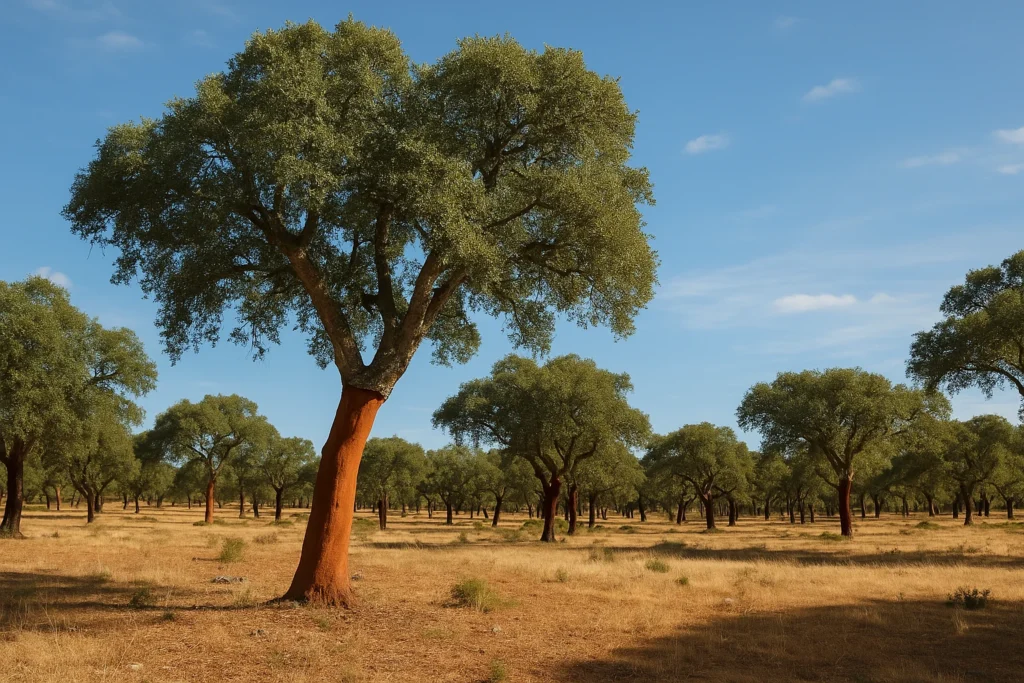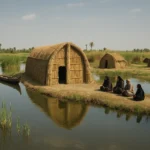Introduction: The Hidden Treasure of Alentejo – Where Ancient Wisdom Meets Modern Sustainability
Under the radiant, benevolent gaze of the golden Portuguese sun, specifically within the sprawling, sun-drenched landscapes of the Alentejo region, an extraordinary and ancient natural treasure quietly yet profoundly thrives. These are the montados, vast and breathtaking cork oak forests that have, over countless centuries, intrinsically woven themselves into the very fabric of the land, shaping its contours, dictating the rhythm of its culture, and providing the robust pulse of its economy. These aren’t merely picturesque woodlands; they stand as a formidable and dynamic fortress against the escalating threats of climate change, serving as a living, breathing testament to a profound and enduring commitment to sustainable living—a legacy passed down through generations.
What sets these forests apart, fundamentally distinguishing them from the more common industrial timberlands, is their unique relationship with the majestic cork oaks, scientifically revered as Quercus suber. Here, the trees are not destined for the sawmills. Instead, with a meticulous care that borders on reverence, their thick outer bark is expertly stripped away every nine years. This process, astonishingly, inflicts absolutely no harm upon the tree itself. On the contrary, this rhythmic, cyclical harvesting allows these resilient giants to extend their lifespans to an astounding over 200 years, diligently working as atmospheric purifiers, absorbing vast quantities of carbon dioxide. In this extraordinary symbiotic dance, they not only sustain themselves but also nurture and support one of the most biodiverse and ecologically rich ecosystems found anywhere across the European continent.
Yet, the remarkable narrative of cork stretches far, far beyond its venerable and traditional role as the humble stopper for a bottle of fine wine. This extraordinary natural material is now making significant and exciting ripples across an astonishing spectrum of global industries, its versatility proving invaluable from the high-fashion runways to the cutting-edge laboratories of spacecraft engineering. And woven into the very DNA of every single cork harvest, every perfectly peeled slab of bark, lies a compelling and intricate narrative steeped in deep-rooted tradition, meticulous craftsmanship, and an innate, profound ecological wisdom that has been carefully nurtured and passed down through countless generations, embodying a harmonious coexistence between humanity and nature.
Why Cork Forests Are a Climate Hero: Guardians of the Atmosphere and Biodiversity
1. Carbon Capture Powerhouses: The Silent Absorbers of Our Planet’s Breath
Imagine a vast, verdant lung for the planet, tirelessly inhaling the very pollutants we exhale. That is precisely the role played by cork oak forests, standing as exceptional and unparalleled carbon sinks. The ecological brilliance lies in a fascinating, counter-intuitive truth: a single cork oak tree that has been harvested for its bark can, remarkably, absorb up to five times more CO₂ from the atmosphere than an identical tree left untouched. This accelerated absorption is a direct consequence of the tree’s biological imperative to regenerate its bark, a process that demands a significant draw of carbon from the surrounding air. The sprawling montados of Portugal, acting as an immense natural carbon reservoir, are estimated to sequester an astounding 14 million tons of CO₂ annually. To put this monumental figure into perspective, it astonishingly equates to offsetting the entire annual emissions generated by 3 million passenger cars. These silent, steadfast guardians are relentlessly working to rebalance our planet’s delicate atmospheric equilibrium, actively mitigating the impact of greenhouse gases with every passing season. Their continued existence is not just beneficial; it is a critical component of our global environmental health strategy.
2. A Sanctuary for Biodiversity: Europe’s Untamed Eden
The montados are not merely forests; they are a vibrant tapestry of life, often affectionately bestowed with the grand title of “Europe’s Amazon.” This moniker is not an exaggeration; their ecological richness and biodiversity are nothing short of astounding, rivaling some of the world’s most pristine wildernesses. These diverse and structurally complex forests provide an invaluable sanctuary and a thriving, intricate home for an incredible array of life, creating a complex web of interdependencies:
- Within their protective embrace roam critically endangered species that are emblematic of European conservation efforts, such as the elusive and majestic Iberian lynx, a creature of myth and beauty, and the graceful black stork, a magnificent raptor whose presence signifies a healthy and undisturbed ecosystem.
- The air above them resonates with the calls of over 160 distinct bird species, their songs filling the canopy and their varied presence indicating a vibrant, healthy, and dynamically balanced environment. From tiny warblers to powerful eagles, the avian diversity is breathtaking.
- A myriad of other wild inhabitants contributes to this rich tapestry, from wild boars foraging tirelessly beneath the dappled canopy to graceful deer Browse delicately on the undergrowth, and even rare and sought-after mushrooms springing forth from the rich, organic soil after a refreshing rain.
The unique, somewhat open canopy structure of the cork oak forests is another key to their biodiversity. Unlike dense, closed-canopy forests, this allows dappled sunlight to penetrate and reach the forest floor. This interplay of light and shadow creates a rich mosaic of diverse microhabitats, each with its own unique conditions. This intricate patchwork fosters an astonishingly complex web of life, supporting both a vast array of flora—from wildflowers to shrubs—and a thriving, interdependent community of fauna. It is a living, breathing testament to nature’s intricate balance, a balance that has been meticulously maintained through centuries of symbiotic relationship between the ancient trees and the human communities that depend upon them.
3. Drought-Resistant and Fire-Retardant Champions: Resilience in a Changing Climate
In an era increasingly defined by devastating wildfires and escalating climatic uncertainties, cork oak trees possess an inherent, almost miraculous advantage: their thick, multi-layered bark is naturally and remarkably fire-resistant. This unique biological armor acts as an incredibly effective insulating layer. Should the fierce outer flames consume the outermost layer, the crucial living tissues beneath are often protected, allowing the tree to survive and, eventually, regenerate its valuable bark. This inherent resilience provides a vital natural firebreak in landscapes prone to ignition, slowing the spread of infernos and offering critical protection to both the ecosystem and surrounding communities. Furthermore, these trees are uniquely and superbly adapted to thrive in the hot, arid climates characteristic of southern Portugal and other Mediterranean regions. Their deep root systems allow them to access subterranean water sources, making them extraordinarily resilient to prolonged periods of drought and perfectly suited to the hotter, drier conditions brought about by climate change. They are not just surviving; they are flourishing, standing as living symbols of endurance and adaptability, standing firm against environmental challenges that often decimate lesser species. Their continued presence is a beacon of hope for natural resource management in a warming world.
From Wine Stoppers to Spacecraft: The Infinite Versatility of Cork
1. The Wine Industry’s Best Friend: A Perfect Marriage of Nature and Craft
For countless centuries, cork has reigned supreme as the undisputed and universally preferred seal for wine bottles. Its unique combination of properties—unparalleled elasticity, allowing it to conform perfectly to the neck of a bottle, and its inherent impermeability, creating a flawless barrier against oxygen—makes it the ideal guardian for preserving the delicate flavors and aromas of fine wine. The historical and cultural bond between cork and wine is profound, a testament to the material’s enduring quality and perfect suitability. What many connoisseurs and casual drinkers alike might not fully grasp is the sheer dominance of Portugal in this venerable industry: an astonishing 70% of the entire world’s cork production originates from this very nation’s sun-drenched montados. This symbiotic relationship underscores Portugal’s pivotal role in global viticulture, ensuring that wines across the globe arrive at our tables in perfect condition, thanks to this natural wonder.
2. Sustainable Fashion & Design: Where Eco-Consciousness Meets Modern Style
In a truly exciting and innovative evolution, forward-thinking designers and material scientists are now completely reimagining cork, transforming it from a rustic material into a surprisingly versatile, stylish, and highly sought-after component in the world of modern aesthetics. It is no longer just a functional material; it is now the star of a new wave of sustainable luxury:
- It is being crafted into chic, sophisticated vegan handbags and shoes, championed by pioneering and ethical brands like Pelcor and Corkor. These creations offer a truly compelling and environmentally conscious alternative to traditional animal leathers, providing guilt-free elegance for the discerning consumer.
- Cork is also being transformed into eco-friendly flooring and elegant wall panels, bringing a touch of natural warmth, exceptional insulation, and superb acoustic properties to modern homes, commercial spaces, and minimalist offices. Its natural patterns and textures add an organic beauty that synthetic materials simply cannot replicate.
- Beyond apparel and interiors, cork’s adaptability is being explored in a myriad of accessories, appearing in everything from luxurious, lightweight watches to durable, impact-absorbing phone cases, demonstrating its remarkable ability to blend high-end aesthetics with everyday practicality and robust protection.
This enthusiastic embrace of cork in contemporary fashion and design is far more than just a fleeting trend; it represents a significant and growing movement towards more conscious consumption, ethical production, and sustainable aesthetics. It is a testament to cork’s unexpected elegance and its capacity to meet the demands of modern design while respecting the planet.
3. High-Tech Applications: Cork’s Unseen Contributions to Cutting-Edge Innovation
Beyond its venerable traditional uses and its burgeoning role in sustainable aesthetics, cork’s inherent physical properties make it an unexpectedly ideal candidate for cutting-edge technological applications, pushing the boundaries of what a natural material can achieve. Its remarkably lightweight nature combined with exceptional heat-resistant and insulative properties has propelled it into truly unexpected and demanding realms:
- It has played a crucial, though often unseen, role as critical insulation for NASA spacecraft, including components of the Space Shuttle. Here, cork’s ability to withstand extreme temperatures and provide reliable thermal protection is absolutely vital, shielding sensitive equipment and brave astronauts from the brutal thermal fluctuations of outer space and re-entry.
- In the rapidly evolving automotive industry, cork is being ingeniously incorporated into electric vehicle battery components. Its properties contribute to improved efficiency, thermal management, and safety within battery packs, a critical factor as electric vehicles become more powerful and ubiquitous.
- Furthermore, cork’s superior natural sound-dampening and acoustic properties make it an ideal material for acoustic panels within world-class concert halls, recording studios, and performance venues. Here, its ability to absorb and diffuse sound waves creates unparalleled auditory experiences, ensuring every note and voice is heard with perfect clarity.
These sophisticated and innovative uses highlight cork’s incredible versatility and adaptability, proving its invaluable utility and performance capabilities far beyond its humble, rustic origins. It truly is a material of the past, present, and future.
The Human Side of Cork: A Craft Passed Down Through Generations – A Symbiotic Relationship
1. The Art of Cork Harvesting: A Timeless Dance with Nature
The harvesting of cork is not merely a job; it is, at its heart, a highly skilled, manual process, an ancient art form, a living tradition that has remarkably remained largely unchanged for centuries. The master artisans of this demanding yet deeply fulfilling trade are known as tiradores, a term that evokes respect for their unique expertise. With a profound, almost innate understanding of the trees and their individual rhythms—a knowledge often passed down from father to son for generations—they meticulously and carefully peel the thick bark using a specialized, hand-forged axe. Every single cut is made with astonishing precision and care, ensuring that the crucial cambium layer beneath is left entirely unharmed, allowing the tree to fully regenerate its bark over the next nine years.
“It’s not just work; it’s a profound dance with nature,” shares João Mendes, a tirador whose weathered hands and knowing eyes proudly represent the third generation of his family dedicated to this demanding yet profoundly rewarding profession. João’s voice, seasoned by years under the sun, carries the weight of ancestral wisdom. “You have to truly know the tree, understand its character, and respect its rhythm. Each cut isn’t just a physical action; it’s a conversation, a quiet whisper between the human hand and the ancient oak. You feel the tree, you listen to it.” This isn’t merely extraction; it’s a deep partnership, a testament to a truly sustainable coexistence where human ingenuity harmonizes perfectly with nature’s cycles. The process is a meditation, a physical manifestation of patience and respect for the natural world.
2. A Way of Life Under Threat: Navigating Modern Challenges with Ancient Resilience
Despite the undeniable ecological and economic benefits that cork offers, this venerable industry, and the unique way of life it supports, is not immune to the complexities and challenges of the modern world. It faces several contemporary pressures that demand innovative responses:
- The increasing global proliferation of plastic and metallic screw-top wine closures has, in certain markets, posed a significant challenge, eroding the traditional demand for natural cork stoppers. This shift necessitates diversification and new markets for cork products.
- Rural depopulation presents another formidable threat. As younger generations, drawn by the allure of urban opportunities, education, and different career paths, increasingly migrate away from the traditional cork-growing regions, there’s a risk of losing the invaluable generational knowledge and expertise unique to this craft.
- Even the pervasive influence of climate change itself can subtly yet significantly affect tree growth cycles, potentially impacting future yields and the quality of the bark, adding another layer of complexity to forest management.
Yet, despite these headwinds, there is a distinct silver lining, a beacon of renewed hope. A growing global awareness and an escalating demand for sustainable, eco-friendly, and ethically sourced alternatives are ushering in a vibrant new era of hope and opportunity for cork. As conscious consumers increasingly seek products that align with their values of environmental stewardship and social responsibility, cork is experiencing a powerful revival, dynamically repositioning itself as a material of choice for a greener, more sustainable future. This resurgence is not just about economic viability; it’s about validating a centuries-old tradition that was inherently sustainable long before the term became popular.
The Future of Cork: A Blueprint for Sustainable Living – A Legacy for Generations
Portugal’s remarkable cork forests are far more than just a valuable economic resource; they embody a profound, living example of a harmonious and reciprocal relationship between humanity and the natural world. They are a testament to the power of thoughtful stewardship. By consciously choosing to support cork products, by integrating them into our daily lives, we actively participate in a virtuous and interconnected cycle that yields immense benefits for the planet and its inhabitants:
✅ We become active agents in safeguarding invaluable wildlife habitats, ensuring the survival of endangered species and maintaining the delicate balance of complex ecosystems that are critical for global biodiversity.
✅ We actively and powerfully combat climate change, allowing the cork forests to continue acting as a vital, natural ally in the global effort to reduce atmospheric carbon and stabilize our planet’s climate.
✅ We ensure the preservation of ancient traditions and invaluable craftsmanship, protecting not just a material, but a rich cultural heritage, ensuring that the unique knowledge and meticulous skills of the tiradores endure for future generations to cherish and learn from.
As the world intensifies its urgent search for viable, green solutions to the pressing environmental challenges of our time, the humble yet extraordinary cork oak stands tall and proud. It serves as a compelling, elegant, and timeless reminder that sometimes, the most innovative and profoundly effective answers are not found in cutting-edge laboratories, but are instead those that nature, in its infinite wisdom and enduring cycles, has already provided. The montados are more than just trees; they are a blueprint, a living model for a future where economy, ecology, and culture can not only coexist but truly thrive in unison, offering a path towards genuine global sustainability.
How You Can Support Cork Sustainability: Be a Part of the Solution
Your individual choices hold tangible power and can make a significant, collective difference. By actively embracing cork and understanding its story, you become a vital part of this inspiring sustainable narrative:
- Choose cork over plastic whenever and wherever possible—whether it’s opting for a bottle of wine sealed with a natural cork stopper, selecting stylish and durable cork accessories for your everyday life, or bringing the natural warmth, beauty, and insulation of cork into your home decor and architectural choices.
- Consider visiting the cork forests for an enriching and unforgettable eco-tourism experience. Regions like Alentejo offer expertly guided tours that provide an intimate, first-hand look at this unique ecosystem, the traditional harvesting process, and the vibrant communities that depend on it. It’s an immersive way to connect with the source.
- Become an advocate: Spread awareness about cork’s incredible environmental benefits, educating your friends, family, and wider community about its multifaceted role in fostering a truly sustainable and regenerative future. Share its story, its benefits, and its potential.
Portugal’s cork forests are not merely surviving the challenges of the modern world; they are actively thriving, flourishing, and expanding their vital role. And in their continued existence, their remarkable resilience, and their profound adaptability, we might just discover the definitive blueprint—the very essence—for a truly sustainable and harmonious future for all.



